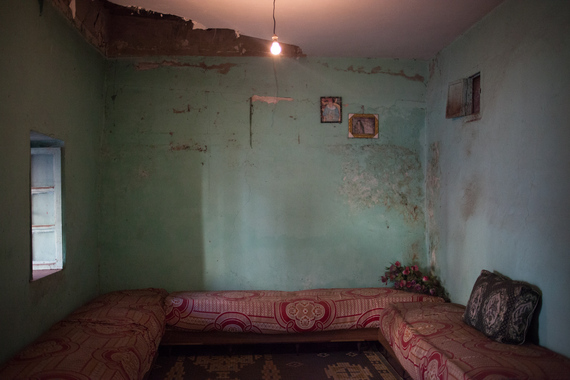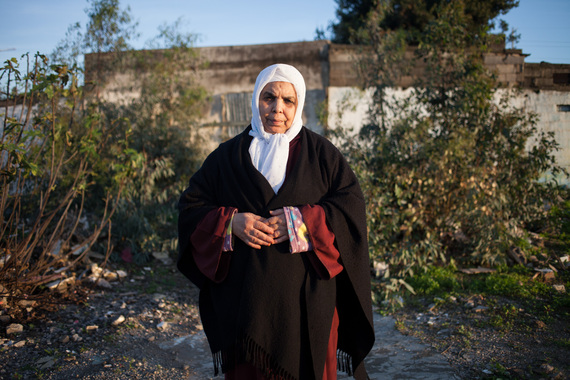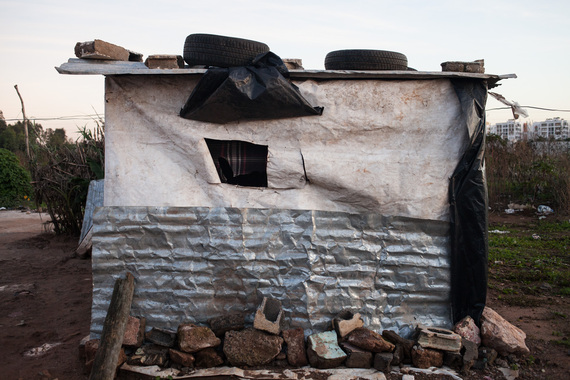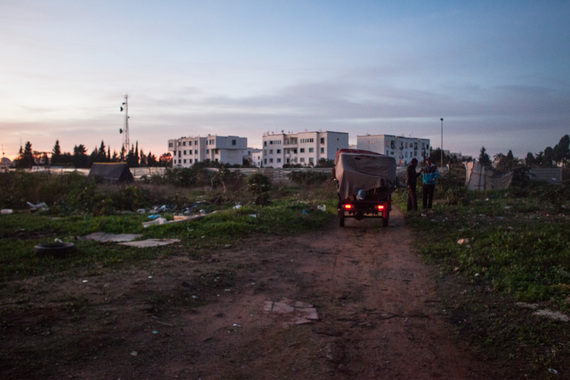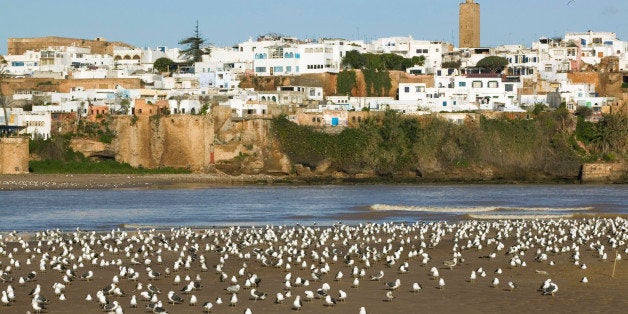
During the morning of December 18, 2014, a tall metal barrier encircled the scene of a mass forced eviction in Douar Ouled Dlim. Located on the outskirts of the wealthy Hay Riad neighborhood in Rabat, nine tractors, dozens of riot police in full gear, along with dozens of other fully uniformed gendarmes and their superiors greatly outnumbered the inhabitants as their homes were destroyed one by one. Those who had the time and the forewarning removed their belongings from their homes in anticipation of the destruction, while others refused to budge in protest of evictions. For months now, a Facebook page calling for solidarity and support with the inhabitants has been closely following events as they have unfolded on the ground.
A community of about 120 families, Douar Ouled Dlim is part of the larger guiche community -- a collection of tribes whose forefathers served in the army of some of the earliest Moroccan sultans of the current ruling Alaouite dynasty. Douar Ouled Dlim comprises just a part of the larger Guiche L'Oudaya, Rabat's guiche community. The guiche community was historically scattered around the major imperial cities of Morocco, including Rabat, Fes, Marrakech and Meknes. Today, these historically-significant communities are dwindling as their lands are sold and used for commercial and real estate development.
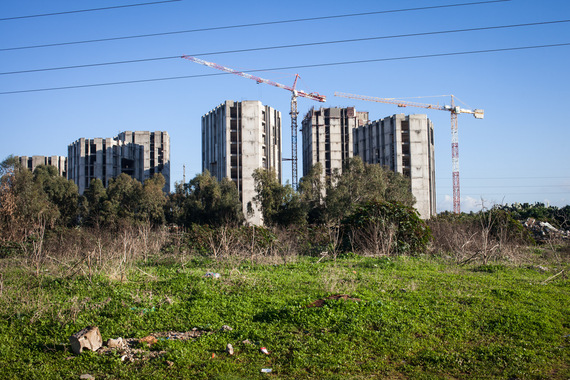
Image of real estate development on the land of Douar Ouled Dlim outside of Rabat's wealthy Hay Riad neighborhood. Image by Rodrigo Avellaneda.
A Brief History of Land Expropriation:
In order to better understand the particularities of the guiche community, it is imperative to briefly delve into the changes of land and agrarian policies in Morocco that were wrought on by French colonialism. Members of the guiche community are commonly known and associated with certain swathes of land outside these major cities. Under the protection of the state and prior to French colonialism, members of the guiche community were given certain amounts of land in exchange for their military services. According to Négib Bouderbala of the Institut Vétérinaire Hassan II, before Morocco fell under the control of the French during 1912, the lands of the guiche community totaled about 768,000 hectares throughout the country.
Through the Moroccan government's guiche statute, which determined the status of guiche land in Morocco, these lands came under the state's protection as a part of the state's "private domain." However, under the French protectorate, nearly 23 percent of guiche land became fully privatized and placed under the control of its inhabitants instead of the state, a policy that persisted throughout the subsequent decades. This mass privatization of guiche land was symptomatic of the land expropriation and tenure policies brought on by French colonialism. These policies also sought to establish a distinction between what belonged to the "state" and what belonged to the sultan.
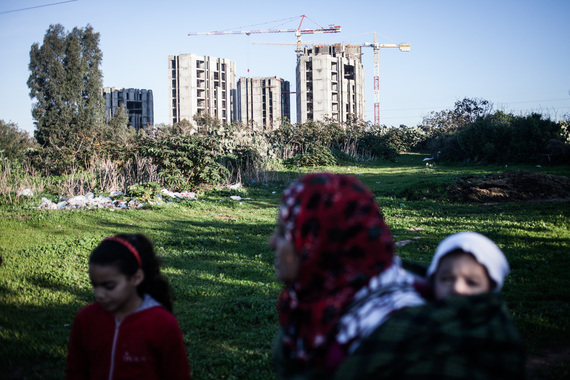
Image of a family from Douar Ouled Dlim with real estate development on their land meters away. Image by Rodrigo Avellaneda.
Following Morocco's independence in 1956, a number of these land policies that entailed mass privatization were reversed, placing the land back under the control of the state, and more specifically, under the person of the sultan--who now bares the title of king. Consequently, the allocation of that land was, in many instances, redistributed on the basis of patronage in exchange for political support. These changes were introduced through a series of royal decrees from 1958 to 1965. By 1999, official guiche lands numbered 208 hectares.
Navigating Confusion and Misinformation
The back and forth between the legal ownership of guiche land has been one of the many sources of confusion and misinformation associated with this community. Despite the massive reduction in guiche land from 1912 to 1999, according to Négib Bouderbala, land that no longer retained its status as guiche land still held the guiche-associated name. While some guiche lands remained under state control, such as Rabat's Guiche L'Oudaya, throughout the 1970s and 1980s, the state began offering monetary compensation and apartments to inhabitants. The state's compensation was offered as the state began selling guiche land for real estate and commercial development projects. Under the leadership of Driss Basri who served as Minster of Interior from 1979 to 1999, the Ministry of Interior relied on members of Guiche L'Oudaya community to devise a census that held a record of all original guiche families. Depending on the size of their land and number of family members, guiche families received varying forms of compensation.
These state handouts drew a number of opportunists, according to a member of the Souini family, one of the original families of Guiche L'Oudaya near Temara. "There were some guiche families who willingly sold their land to outsiders by the meter. This created a major influx of non-guiche families on guiche land," said a member of the Souini family who spoke on the condition of anonymity. In order to establish an address on guiche land with the expectation of receiving state compensation, these outsiders would build makeshift homes in the form shanties, or brarrek, as they are commonly referred to in Moroccan colloquial Arabic.
"Back then, you could easily determine who was an original guiche family member from those who were not based on the construction of their homes. Moreover, the families were known to one another," explained a Souini family member. This influx of non-guiche residents stalled the state compensation program, leaving many original guiche families uncompensated and homeless, while some among the non-guiche families received sums of money and apartments. Said Belquish, a resident of Douar Ouled Dlim which faced eviction on 18 December, derailed the state's inability to distinguish between the original inhabitants versus what described as the "foreigners." Pointing to the real estate development encroaching upon their land just a few blocks away, Said asserts, "Now you have Doukalla [families originally from El Jadida outside Casablanca] benefiting from what we are entitled to."
Between Ministries and Real Estate Development Companies
A number of inhabitants in Douar Ouled Dlim decried the 2003 agreement between the Ministry of Interior and the real estate development company Société d'aménagement Ryad (SAR), which falls under the control of the state-owned financial institution, the Caisse de dépot et de gestion (CDG). Through this agreement, the Ministry of Interior sold Guiche L'Oudaya land to SAR to further develop the wealthy Hay Riad neighborhood in Rabat. This agreement is also related to the broader urban policies under the jurisdiction of the Ministry of Housing tasked with replacing shantytowns with permanent public housing through apartments.
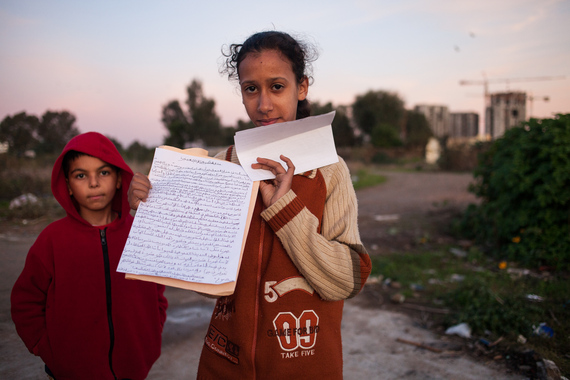
A young girl from Douar Ouled Dlim holds a letter she wrote describing the struggles of her family and community. Image by Rodrigo Avellaneda.
An official with the Ministry of Housing explained to me that, "The issue with guiche land arises when the communities begin expanding in major urban cities through the construction of shanties, which trigger a series of social issues associated with shantytowns."
One of these issues the official highlighted was the rise in crimes. "It is then," the Ministry of Housing official explained "that we get involved by either reconstructing the infrastructure on their land or moving them to another area with housing that corresponds to the amount of land they previously lived on."
The role of the Ministry of Housing is primarily financial through its collaboration with other ministries and companies, including Groupe Al Omrane, the Ministry of Interior, the Ministry of Health, and the Ministry of Education. "Our role is to provide financial resources distributed from the Fonds Solidarité Habitat," explained the official. The Fonds Solidarité Habitat was established in 2001 following a royal decree intended to "combat unsanitary living conditions."
The collaboration of these ministries and companies has resulted in inconsistencies, as demonstrated with the case of Douar Ouled Dlim. A number of the inhabitants explained that while the Ministry of Housing and Groupe Al Omrane have asserted that the housing is ready and available, they are unable to act without the authorization of the Ministry of Interior. Officials at the Ministry of Interior declined to comment or claimed to have no knowledge about the land evictions taking place in Guiche L'Oudaya. Even the official at the Ministry of Housing was unable to clarify these inconsistencies, citing the inability to interfere in the affairs of other ministries.
Regardless of these inconsistencies and miscommunication, the 2003 agreement set off a series of forced evictions through the demolishment of homes and the removal of utility services, including water and electricity. While some members of the 120 families of Douar Ouled Dlim were promised compensation and apartments, others have yet to receive word of any redress, leading some to the desperation of self-immolation. Yet those who remained until the morning of 18 December 2014 all shared the same fate of forced eviction, rendering them internally displaced--just meters away from their own land. Any attempt to reconstruct any form of housing, even through tents, is met with the immolation of their belongings. "We are told that we will hear back from the officials once the demolition is complete," explained Said Jamali of Douar Ouled Dlim to me on the night before his home was demolished. Another resident, Habiba, stood just meters away form where her home once stood days following the demolishment of her home, telling me through her tears, "Where are we supposed to go now? Is this not a form of occupation?"

